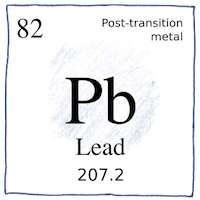Çatalhöyük
elements

|
Lead
Lead statuette from the Temple of Osiris, 3800 BCE, lead beads from Çatalhöyük, 6400 BCE, beginning the use of lead as early as 7000 BCE as lead is easy to smelt and easy to work.
Atomic number 82
Lead ores contain silicates, sulfides, arsenides, and traces of copper, silver, zinc, cadmium, arsenic, bismuth, antimony, and gold. Silver ores contain lead. Silver mining is one reason the Romans had so much lead. Lead beads, lead statuettes, lead preservatives in their food and drink, lead plates and lead pipes made the Romans slightly mad. Lead glass and stained glass glazing, lead pottery glazing, lead bullets and shot, lead lineotype type, lead paint, lead-acid batteries, leaded gasoline, lead weights for fishing and balancing wheels, and toy soldiers made of lead.
Lead poisoning
Lead-210 makes lead ore a little radioactive but, far worse, if animals like us eat lead or breathe lead dust, the lead interferes with red blood cells, nerve signaling, and the development of the nervous system, resulting in pain, confusion, anemia, seizures, coma, death, and permanent learning disorders in children. The odd thing is for many, many years, people didn’t think that lead was bad for us.



I owned a house that had been the location of a farmhouse garbage dump. Digging postholes in the yard at different times, I found two lead toys. One was a soldier with a missing leg; the other was a gasoline tanker truck.
See also in The book of science:
Readings in wikipedia:
Other readings: